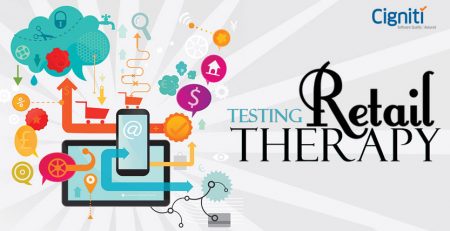How to Amplify the Impact of Virtual Reality with a Robust Test Strategy?
Beyond the usual, today Virtual Reality (VR) is being leveraged to generate empathy. Unicef is leveraging VR to convey the quantum of work and the intensity of the crisis situation, which goes beyond just reading stories and viewing images. It is being considered as an immensely powerful tool to generate support and give human voice to the initiatives undertaken by Unicef around the world. A very recent instance is the Syrian refugee crisis and the work done around it.
This validates and establishes the impact of VR, which goes beyond mere gaming and infotainment. 2016 has been considered by experts and analysts as the breakthrough year for the VR industry. According to Deloitte, the industry is estimated to break the $1 bn barrier for the first time. Goldman Sachs forecasts that the VR market worth can grow up to $80 bn by 2025 as the opportunities get bigger and bigger.
With some globally popular brands setting their foot in the space, VR is getting its share in the mainstream. Samsung launched its Gear VR headset, Facebook is creating buzz with its Oculus Rift, HTC’s Vive has released, and there are many more to come our way. While these are some high-end options, there are some cheap options available to give that ‘experiential’ value to the interested folks.
How well it is going to be embraced in the mainstream, boils down to its acceptance levels. Any new technology when introduced in the market tends to be costly and sometimes exorbitant. However, there are brands that believe in offering the audience a test drive with the new technology.
Testing and experience goes hand in hand for Google Cardboard. It is giving users the edge to experience VR on a low-cost platform, which has been questioned by VR enthusiasts.
So be it!
Experiential approach in testing goes way ahead in the technology curve to create enthusiasm and drive acceptance for any novel concept. It is a much needed step to sustain the interest in the nascent VR market.
Interestingly, The New York Times is embracing the idea, as it will distribute over a million Google Cardboards with its Sunday print subscribers. This is a classic instance of how Media whether traditional or new always helps and propagates the idea of ‘testing the NEW’.
While testing the device is one thing, testing the applications is of greater significance. Google Cardboard has come up with some applications like, Cardboard Camera App that facilitates a stereoscopic panorama to view with Google Cardboard. Similarly, Orbulus is a must-have VR smartphone app that takes you around the globe with a massive 216MB download. These are some extremely striking examples of applications that are mostly free and out there in the marketplace to test consumer behavior and response.
Likewise, there are simple tools in the marketplace for techies to test the readiness of the PC for VR. For example, SteamVR Performance Test is a simple tool that helps evaluate your PC’s compatibility with the VR application. Alternatively, experts are considering and evaluating the use of Test Automation with required mix of Unit tests, Acceptance tests, and Regression tests of the code.
With a market that promises growth and serious investment at the same time, what makes testing these applications so critical? Specifically, how critical is testing for a VR app?
Testing essentially confirms the correct or expected behavior of any particular application or device at hand. VR applications are expected to, and are practically being implemented across various industry domains. Testing of VR applications has its own nuances, due to its complexity and aspects pertaining to human-machine interface.
Manual Testing is considered for evaluating the application’s user interaction and automated testing is implemented for internal application components. Manual tests specifically help to gauge the user’s interaction with the applications and whether it leads to the desired outcome.
User interfaces for VR applications are much more complex and must consider a different testing approach. It does not implement usual interaction handler to process the data from the device; alternately, it processes the device’s input directly. The purpose behind this is to comprehend the overall impact of the environment on the device and how all this assimilates for the user in the virtual environment. In order to process such high degree of interaction and weigh the input and corresponding output, automating a chunk of tests is absolutely indispensable.
Experts say that there is no specific or accepted pattern for automated testing of VR applications. Currently, the industry is implementing existing software engineering practices and applying them for testing VR applications. Considering the high intensity of human-machine interface, conventional testing processes can fall short of meeting the requirements.
What is recommended, is a comprehensive testing architecture that addresses specific issues concerning the testing needs for VR applications.
A number of companies across sectors are integrating their VR applications within their sphere of work. For instance, Ford designers and engineers are leveraging VR to test elements of new cars and have been saving around $8 million in a year. Airbus is using it for showcasing Demo for customers. On the critical end, Surgeons at UCLA are implementing Surgical Theatre’s medical VR technology and Oculus Rift to test-run some extremely sensitive surgeries before the actual operation.
All thanks to the diverse and widespread application of VR, today it is being leveraged by leading global institutions like Unicef to showcase their work to corporate partners, foundations and philanthropists to garner the required support for a much larger cause.
Cigniti Technologies has been empowering enterprises and brands to increase release velocity, reduce time to market and cut overall testing effort, resulting in higher return on investment (ROI). Cigniti Test Automation Accelerator Kit (GTAAK) comprises of pre-built test automation scripts, utilities, process assets and frameworks, and has helped enterprises to implement successful test automation initiatives. Contact us to know more.





Leave a Reply